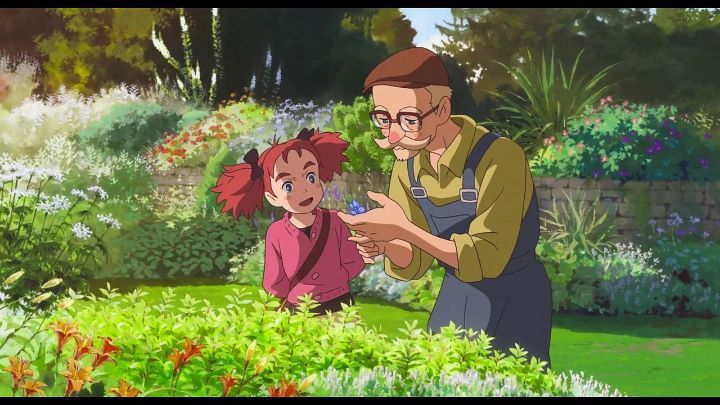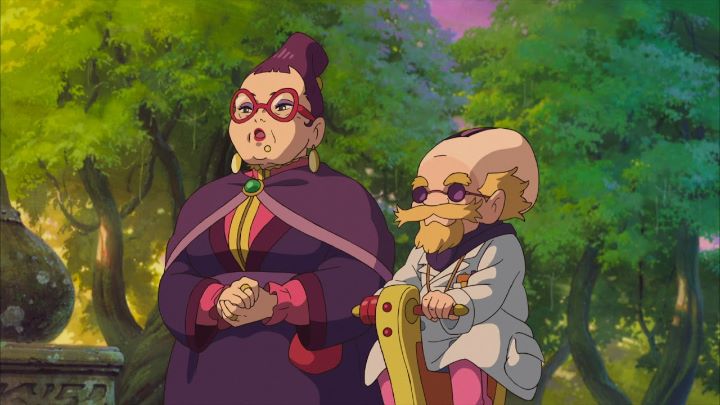






Few animation studios, save perhaps for Walt's era of the Disney Studio in the USA, have ever had the respect and pedigree that Studio Ghibli of Japan had. In 2013 and 2014, the studio released three feature films in "The Wind Rises," "The Tale of Princess Kaguya," and "When Marnie Was There," each quality films to their catelog by their best (and only) directors at a desnser release schedule than what they had previously seen. But Hayao Miyazaki was announcing his retirement, and being in his mid-70's, it was expected he meant it this time. Isao Takahata was even older, and while he claimed to want to make more movies, even he knew it was unlikely he would ever finish another with his production dendencies (he would sadly pass away in 2018). Hiromasa Yonebayashi was a younger and promising director, but was generally more comfortable with adaptations rather than helming unique visions, and was unlikely to be able to carry the studio's weight on his shoulders alone. So it came to no surprise that the studio announced it was shutting its doors in 2014, only to run its museum and maintain licensing for its past films. An era had come to a close.This is why such hope was put behind the newly formed "Studio Ponoc" in 2015, a group formed by many of new ex-Studio Ghibli animators and creatives. Yonebayashi himself would direct their first feature film, released in 2017 as "Mary and the Witch's Flower." It appeared to be a family fantasy animation very much in the vein of Studio Ghibli's traditions, based on an older European children's story. GKIDS, at this point the exclusive American distributor to Ghibli's movies, would proudly accquire "Mary," and upon giving it a limited theatrical release (as they tend to do with their international films on occasion), they said it broke their records as their most successful film with American audiences, and it beat international box office income even against some of Ghibli's last films. Fans craved a new Ghibli, and most reviews were understandibly good, but not great. Personally, I am thankful "Mary and the Witch's Flower" wasn't released under Ghibli's banner, for if it was, it would easily be their worst film. And yes, I include "Ponyo" and "Tales from Earthsea" in my comparisons.It certainly LOOKS like a Ghibli movie, and that's the most refreshing part. From the outset, the hand-painted backgrounds and digitally-painted animals and characters look and animate distinctly like many of those classic films. Look closely, and you might even recognize specific scenes or buidlings that directly recall elements of "Princess Mononoke," "Spirited Away," or "The Cat Returns," and many others. For fans who thought they never thought they would see a film that looked like this again, it was a dream come true (I briefly cried in the theater just in the opening minutes). If looking critically, one might be more judgemental on the designs and their originality, but not overtly so. The music is also one of the film's best highlights; most of Ghibli's best scores came from Joe Hisaishi, but the score for "Mary" came Takatsugu Muramatsu, a relatively new composer who had just scored "When Marnie Was There." But he is a skilled artist, and the music does a lot to give "Mary" its personality and magical tone, the most memorable tracks making simple but inspired use of a harpsichord. As for the story, it follows a sweet young girl named Mary Watson, temporarily living with her kind Aunt in rural Britain before starting the new school year, and waiting for her parents to return for her from their work. Mary has messy red hair, and in her eagerness seems especially clumsy, both of which ruins her self esteem. After a small event of exploring the nearby woods with two cats, she discovers a rare blue flower, and a lone broomstick left amongst the tangled roots of a tree. The flower's sap gives her temporary magical powers, and against her will, the broom takes her "home" to a magical school in the sky, where witches exists and train their craft.  Initially, it seems very "Harry Potter" -like, but for a younger audience. But Mary's tour of the magical school barely lasts five minutes, after which the plot takes over, forcing Mary to confront a dark scheme that theatens her friend Peter (as children would do, Mary is a girl and Peter is a boy, so they immediately don't get along well but don't wish particular harm on either). In those five minutes, Mary shows through careful fibbing and a couple accidents that she is so skilled that even their most elite classes are too easy for her. It's nice to see her feel confidence in herself for once (this is the big theme of the movie, if there was one), but otherwise the existance of a magical school is irrelevant to the story. It would have been better to make the story more concise and simply make it a magical labratory, or else to spend an extra ten minutes on the school. Otherwise, the plot still feels trite due to poor characterization and dialogue. All of the characters feel one-dimensional, kept simple as if to make it easier for children to enjoy, rather than the more subtle characterizations better films use that both children and adults could appreciate, while the second half of the movie is likely too complicated for a younger audience to understand. The English dub commits to the setting by casting UK actors, going so far as using English slang like "rubbish" and "brilliant" to make it feel more authentic (and again, to feel more like the "Harry Potter" franchise). But not even the talents of Kate Winslet or Jim Broadbent can save the awkward script, and the Japanese dub doesn't improve things either. It isn't a compliment to say that Mary's dancing broom is the most complex character of the entire movie. The movie is simply too short, and too many elements were eagerly thrown in without necessary expansion, to have the story or its world come together in a satisfying way.Both the plot, dialogue, and some of strange visual choices could have been fixed with careful directing, but a senior mentor didn't exist on this production. So yes, "Mary and the Witch's Flower" would easily be the worst Ghibli movie, almost entirely because of a weak plot. But even the "worst" Ghibli movie is a magical experience that exceeds most other family films. And there are enough fun little scenes, be it the eager broom, Mary's humorous outbursts or monologues, or the use of animals in the movie, to bring a smile to even the hardest hearts. This lighthearted tone, along with the generally solid visuals from the animator's experiences, make "Mary and the Witch's Flower" still a movie worth recommending, especially for younger audinces too young for "Howl's Moving Castle" and too old for "My Neighbor Totoro." I am hopeful that Studio Ponoc will grow from their experience and will be able to make more films that solidify them as a international talent in their own right. If not, at the very least we'll have a few more "Ghibl-esque" films to look forward to in filling the void in our hearts.
Initially, it seems very "Harry Potter" -like, but for a younger audience. But Mary's tour of the magical school barely lasts five minutes, after which the plot takes over, forcing Mary to confront a dark scheme that theatens her friend Peter (as children would do, Mary is a girl and Peter is a boy, so they immediately don't get along well but don't wish particular harm on either). In those five minutes, Mary shows through careful fibbing and a couple accidents that she is so skilled that even their most elite classes are too easy for her. It's nice to see her feel confidence in herself for once (this is the big theme of the movie, if there was one), but otherwise the existance of a magical school is irrelevant to the story. It would have been better to make the story more concise and simply make it a magical labratory, or else to spend an extra ten minutes on the school. Otherwise, the plot still feels trite due to poor characterization and dialogue. All of the characters feel one-dimensional, kept simple as if to make it easier for children to enjoy, rather than the more subtle characterizations better films use that both children and adults could appreciate, while the second half of the movie is likely too complicated for a younger audience to understand. The English dub commits to the setting by casting UK actors, going so far as using English slang like "rubbish" and "brilliant" to make it feel more authentic (and again, to feel more like the "Harry Potter" franchise). But not even the talents of Kate Winslet or Jim Broadbent can save the awkward script, and the Japanese dub doesn't improve things either. It isn't a compliment to say that Mary's dancing broom is the most complex character of the entire movie. The movie is simply too short, and too many elements were eagerly thrown in without necessary expansion, to have the story or its world come together in a satisfying way.Both the plot, dialogue, and some of strange visual choices could have been fixed with careful directing, but a senior mentor didn't exist on this production. So yes, "Mary and the Witch's Flower" would easily be the worst Ghibli movie, almost entirely because of a weak plot. But even the "worst" Ghibli movie is a magical experience that exceeds most other family films. And there are enough fun little scenes, be it the eager broom, Mary's humorous outbursts or monologues, or the use of animals in the movie, to bring a smile to even the hardest hearts. This lighthearted tone, along with the generally solid visuals from the animator's experiences, make "Mary and the Witch's Flower" still a movie worth recommending, especially for younger audinces too young for "Howl's Moving Castle" and too old for "My Neighbor Totoro." I am hopeful that Studio Ponoc will grow from their experience and will be able to make more films that solidify them as a international talent in their own right. If not, at the very least we'll have a few more "Ghibl-esque" films to look forward to in filling the void in our hearts.